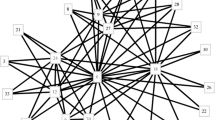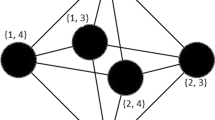Abstract
Given a matroid M defined by an independence oracle on a ground set E, the Matroid Base Game is played by two players: the defender chooses a basis B and (simultaneously) the attacker chooses an element \(e \in E\). The attacker incurs a cost c(e) for choosing an element e, and if \(e \in B\) then there is a probability p(e) that the attacker will detect the defender. The defender has to find a bases-selection strategy that minimizes the average probability of being detected. The attacker has to find a probabilistic selection strategy that maximizes the average detection probability minus its average cost. An algorithm to compute Nash-equilibrium mixed strategies was given in Szeszlér (Math Program 161:347–364, 2016). Its time complexity is \(O(|E|^{10} IO)\), where IO is the time that it takes one call to the independence oracle. Here we present an algorithm that requires \(O(|E|^6 IO)\) time. For graphic matroids, i.e., when the defender chooses a spanning tree in a graph \(G=(V,E)\), and the attacker chooses an edge, we give an algorithm that takes \(O(|V|^4 |E|^{1/2})\) time. This type of game is extended to common bases of two matroids. For this case we give a strongly polynomial algorithm, settling a question that was left open in Szeszlér (2016). We also treat the case when the defender chooses a rooted arborescence in a directed graph \(D=(V,\mathscr {A})\), and the attacker chooses an arc, we use this structure to give an algorithm that requires \(O(|V||\mathscr {A}|^3 \log (|V|^2/|\mathscr {A}|) \log |\mathscr {A}|)\) time.
Similar content being viewed by others
References
Aziz, H., Lachish, O., Paterson, M., Savani, R.: Wiretapping a hidden network. In: Leonardi, S. (ed.) Internet and Network Economics, pp. 438–446. Springer, Berlin (2009)
Barahona, F.: Separating from the dominant of the spanning tree polytope. Oper. Res. Lett. 12, 201–203 (1992)
Barahona, F.: Packing spanning trees. Math. Oper. Res. 20, 104–115 (1995)
Cheriyan, J., Maheshwari, S.N.: Analysis of preflow push algorithms for maximum network flow. In: Nori, K.V., Kumar, S. (eds.) Foundations of Software Technology and Theoretical Computer Science. Springer, Berlin (1988)
Cunningham, W.H.: Testing membership in matroid polyhedra. J Comb. Theory B 36(2), 161–188 (1984)
Dinkelbach, W.: On nonlinear fractional programming. Manag. Sci. 13, 492–498 (1967)
Edmonds, J.: Submodular Functions, Matroids, and Certain Polyhedra. In: Jünger, M., Reinelt, G., Rinaldi, G. (eds.) Combinatorial Optimization — Eureka, You Shrink!: Papers Dedicated to Jack Edmonds 5th International Workshop Aussois, France, March 5–9, 2001 Revised Papers, pp. 11–26. Springer, Berlin (2003)
Edmonds, J.: Matroids and the greedy algorithm. Math. Program. 1, 127–136 (1971)
Edmonds, J.: Edge-disjoint branchings. Comb. Algorithms 9, 91–96 (1973)
Gabow, H.N., Manu, K.: Packing algorithms for arborescences (and spanning trees) in capacitated graphs. Math. Program. 82, 83–109 (1998)
Goldberg, A.V., Tarjan, R.E.: A new approach to the maximum-flow problem. J. ACM 35, 921–940 (1988)
Grötschel, M., Lovász, L., Schrijver, A.: The ellipsoid method and its consequences in combinatorial optimization. Combinatorica 1, 169–197 (1981)
Gueye, A., Walrand, J.C., Anantharam, V.: Design of network topology in an adversarial environment. In: Alpcan, T., Buttyán, L., Baras, J.S. (eds.) Decision and Game Theory for Security, pp. 1–20. Springer, Berlin (2010)
Gueye, A., Walrand, J.C., Anantharam, V.: A network topology design game: How to choose communication links in an adversarial environment. In: Proceedings of the 2nd International ICST Conference on Game Theory for Networks, GameNets, vol. 11 (2011)
Hao, J., Orlin, J.B.: A faster algorithm for finding the minimum cut in a directed graph. J. Algorithms 17, 424–446 (1994)
Laszka, A., Szeszlér, D.: Hide and seek in digital communication: the steganography game, In: Proceedings of the 9th Hungarian–Japanese Symposium on Discrete Mathematics and its Applications, Fukuoka, Japan, pp. 126–136 (2015)
Narayanan, H.: A rounding technique for the polymatroid membership problem. Linear Algebra Appl. 221, 41–57 (1995)
Nash-Williams, C.S.J.: Edge-disjoint spanning trees of finite graphs. J. Lond. Math. Soc. 1, 445–450 (1961)
Neumann, J.V.: Zur theorie der gesellschaftsspiele. Mathematische Annalen 100, 295–320 (1928)
Orlin, J.B.: A faster strongly polynomial time algorithm for submodular function minimization. Math. Program. 118, 237–251 (2009)
Radzik, T.: Fractional combinatorial optimization. In: Pardalos, P.M., Du, D.-Z., Graham, R.L. (eds.) Handbook of combinatorial optimization, pp. 1311–1355. Springer, Berlin (2013)
Schrijver, A.: Combinatorial Optimization: Polyhedra and Efficiency. Springer Science & Business Media, Berlin (2002)
Szeszlér, D.: Security games on matroids. Math. Program. 161, 347–364 (2016)
Tutte, W.T.: On the problem of decomposing a graph into n connected factors. J. Lond. Math. Soc. 1, 221–230 (1961)
Wang, Q., Yang, X., Zhang, J.: A class of inverse dominant problems under weighted \(l_\infty \) norm and an improved complexity bound for Radzik’s algorithm. J. Global Optim. 34, 551–567 (2006)
Acknowledgements
We are grateful to H. Narayanan and to S.T. McCormick for some helpful discussions. We are also grateful to the referees whose comments helped us to improve the presentation
Author information
Authors and Affiliations
Corresponding author
Rights and permissions
About this article
Cite this article
Baïou, M., Barahona, F. Faster Algorithms for Security Games on Matroids. Algorithmica 81, 1232–1246 (2019). https://doi.org/10.1007/s00453-018-0466-x
Received:
Accepted:
Published:
Issue Date:
DOI: https://doi.org/10.1007/s00453-018-0466-x




